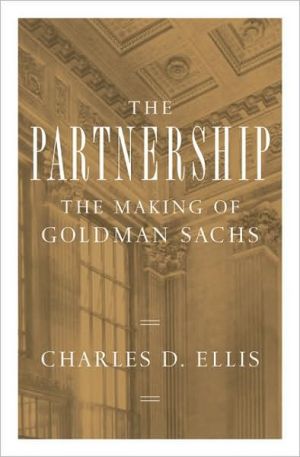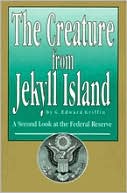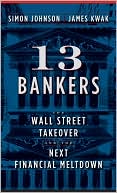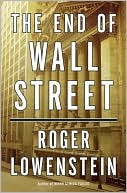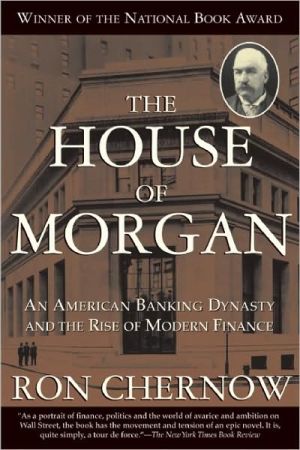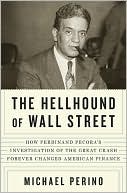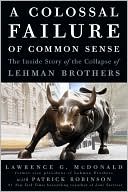The Partnership: The Making of Goldman Sachs
As a strategy consultant to Goldman Sachs for more than thirty years, Charles D. Ellis developed close relationships with many of the firm's past and present leaders. In The Partnership he probes deeply into the most important chapters in the firm's history, revealing the key events and decisions that tell the colorful, character-driven story of how Goldman Sachs became what it is today.
Search in google:
The jury is still out on what the future of Goldman Sachs will look like, but no one can argue that the 139 year old firm has been (and, if Warren Buffett has his way, will be) the dominant investment banker and dealer on Wall Street. What does Buffett see that we on the outside do not? It's all about the people.Charles D. Ellis has written a landmark book that couldn't come at a better time. The Partnership: The Making of Goldman Sachs is the colorful and fascinating story of Goldman's rise to power through many life-threatening changes in markets, competition, and regulation. It tells the personal history of the men and women who built the world's leading financial powerhouse from a firm that was disgraced and nearly destroyed in 1929, limped along as a break-even operation through the Depression and WWII, and, with only one special service and one improbable banker, began the rise that, in half a century, took Goldman Sachs to global leadership.A conversation with Charles Ellis:• Is Goldman Sachs really a lot better than other firms at managing risk? The big difference is in the cumulative power of many “small” details. The difference in the speed, accuracy, and extent of communication inside the firm; the difference in intensity, focus, and disciplined toughness of the men and women hand selected to work there and real difference in recruiting, training, and compensation. All add up to a decisive advantage in management. Leaders and co-leaders manage Goldman's many business units with rigor and drive; risk management is the envy of other banks; and coordination is powerful across business units and markets around the world. As every Olympic athlete knows, such small differences make all the difference between gold, silver or bronze — or no medal at all. In the current, very difficult test, Goldman Sachs has come in 1st — again.• Goldman Sachs is often described as the best managed Wall Street firm. Is that true? Yes, it is true. Goldman Sachs is the best managed “Wall Street” firm — and the best led. Management is why Goldman Sachs is consistently rated the best firm to work for and gets top ratings from clients all over the world. Superior management is why the firm earns more profit, develops more effective people, has made itself the market leader in the U.S., U.K, Germany, France, China, Japan, and in most major lines of banking business. No other firm comes close. One of the things you will learn in The Partnership is just how Goldman succeeded in making themselves different from any other Wall Street firm. They learned early on that in order to survive, they had to not only make money, but create a culture that was universal, that demanded absolutely loyalty and, most importantly, act as one organism. • Why does Goldman Sachs put so much weight on its “culture”? Goldman Sachs culture works. In the complex, fast-changing, global, 24/7 securities business almost all the important decisions are made in highly specific and complex settings under great time pressure. These decisions cannot be made by headquarters and they cannot be deferred. They must be made locally by local market and business experts thousands of times every day. Rules won't work. If rules were written for every type of decision in all those different businesses in all the world's different markets in all the different cultures, the resulting Rule Book would be far too large and complex to read or use. Culture — its way of working — is the universal “stem cell” that enables Goldman Sachs to operate so forcefully in so many different national markets and in so many different businesses.• With all its different business activities all over the world, doesn't Goldman Sachs have problems with conflicts of interest?Yes! The firm certainly has many, many conflicts of interest. While it could take a defensive approach and try to avoid or minimize those risks of conflicts, the firm believes the more realistic and effective approach is to recognize those risks, be candid about them with clients and counterparties, and actively manage the conflicts. The firm strives to deal with each of them in such thoughtful and effective ways that clients and customers will know Goldman Sachs can be trusted to manage conflicts better than any other firm.This is, of course, an assumption of enormous responsibility — particularly on the scale on which Goldman Sachs operates — so it raises the obvious next question: Who will watch the watcher? Publishers Weekly In this history of investment bank Goldman Sachs, Ellis (Winning the Loser's Game) covers the same ground as Lisa Endlich's Goldman Sachs: The Culture of Success-with notable stylistic differences. From Marcus Goldman's purchase of his first commercial paper in 1869 to the firm's current success, Ellis's account is lively and engaging where Endlich's is accurate but dry. Ellis sheds light on events through dialogue and detailed descriptions of people's thoughts and feelings, embellishments that the author terms "recreations" in his epilogue. The effect of infusing such narrative techniques into the history of Goldman Sachs is entertaining, but it pushes the envelope of nonfiction, especially since the author appears to have interviewed only former partners of the firm. More damagingly, Ellis fails to report much about actual business, and attempts to do so-such as a chapter on Rockefeller Center financing-require lengthy digressions and are incomprehensible due to the complexities of the transactions. Without links to business, boardroom conflicts take on the air of petty squabbles. More a composite memoir of senior Goldman partners than a traditional history, this book will satisfy readers curious about the philosophies and personalities of the firm. (Oct.)Copyright © Reed Business Information, a division of Reed Elsevier Inc. All rights reserved.
Introduction\ This book was almost never written—several different times. In the winter of 1963 at Harvard Business School, I was, like all my classmates, looking for a job. My attention was drawn to a three-by-five piece of yellow paper posted at eye level on a bulletin board in Baker Library. In the upper left corner was printed "Correspondence Opportunities" and typed to the right was the name "Goldman Sachs." As a Boston securities lawyer, my dad had a high regard for the firm, so I read the brief description of the job with interest but was stopped by the salary: $5,800.\ My then wife had just graduated from Wellesley with three distinctions: she was a member of Phi Beta Kappa, a soprano soloist, and a recipient of student loans. I was determined to pay off those loans, so I figured I'd need to earn at least $6,000. With no thought of the possibility of earning a bonus or a raise, I naively "knew" I could not make it on $5,800. So Goldman Sachs was not for me. If I had joined the firm, like everyone else who has made a career with Goldman Sachs I would never have written an insider's study of Goldman Sachs.*\ In the early 1970s, while promising future partners that we would develop our fledgling consultancy, Greenwich Associates, into a truly superior professional firm, I had to laugh at myself: "You dummy! You make the promise, but you don't even know what a truly superior professional firm is all about or how to get there. You've never even worked for one. You'd better learn quickly."\ From then on, at every opportunity I asked my friends and acquaintances in law, consulting, investing, and banking which firms they thought were the best in their field and what characteristics made them the best. Over and over again, well past the bounds of persistence, I probed those same questions. Inevitably, a pattern emerged.\ A truly great professional firm has certain characteristics: The most capable professionals agree that it is the best firm to work for and that it recruits and keeps the best people. The most discriminating and significant clients agree that the firm consistently delivers the best service value. And the great firms have been and will be, sometimes grudgingly, recognized by competitors as the real leaders in their field over many years. On occasion, challenger firms rise to prominence—usually on the strength of one exciting and compelling service capability—but do not sustain excellence.\ Many factors that contribute to sustained excellence vary from profession to profession, but certain factors are important in every great firm: long-serving and devoted "servant leaders"; meritocracy in compensation and authority; disproportionate devotion to client service; distinctively high professional and ethical standards; a strong culture that always reinforces professional standards of excellence; and long-term values, policies, concepts, and behavior consistently trumping near-term "opportunities." Each great organization is a "one-firm firm" with consistent values, practices, and culture across geographies, across very different lines of business, and over many years. All the great firms have constructive "paranoia"—they are always on the alert for and anxious about challenging competitors. However, they seldom try to learn much from competitors: they see themselves as unique. But like Olympic athletes who excel in different events, they are also very much the same.\ Armed by Greenwich Associates' extensive proprietary research and working closely as a strategy consultant with all the major securities firms, I was in a unique position to make comparisons between competing firms on the dozens of salient criteria on which they were evaluated by their own clients market by market, year after year, and particularly over time. Over the years, I became convinced that my explorations were producing important discoveries that would be of interest to others who are fascinated by excellence, who retain professional firms for important services, or who will spend their working careers in professional firms. One discovery surprised me: In each profession, one single firm is usually recognized as "the best of us" by the professional practitioners—Capital Group in investing, McKinsey in consulting, Cravath in law (nicely rivaled by Davis Polk or Skadden Arps), and the Mayo Clinic in medicine (nicely rivaled by Johns Hopkins). And Goldman Sachs in securities.\ Ten or twenty years ago, many people in the securities business would have argued that other firms were as good or better, but no longer. (Much further back, few would have ever chosen Goldman Sachs.) For many years, it has seemed clear to me that Goldman Sachs had unusual strengths. Compared to its competitors, the firm recruited more intriguing people who cared more about their firm. Their shared commitments, or "culture," was stronger and more explicit. And the leaders of the firm at every level were more rigorous, more thoughtful, and far more determined to improve in every way over the longer term. They took a longer horizon view and were more alert to details. They knew more about and cared more about their people. They worked much harder and were more modest. They knew more andwere hungrier to learn. Their focus was always on finding ways to do better and be better. Their aspirations were not on what they wanted to be, but on what they wanted to do.\ Goldman Sachs has, in the last sixty years, gone from being a marginal Eastern U.S. commercial-paper dealer, with fewer than three hundred employees and a clientele largely dependent on one improbable investment banker, to a global juggernaut, serially transforming itself from agent to managing agent to managing partner to principal investor with such strengths that it operates with almost no external constraints in virtually any financial market it chooses, on the terms it chooses, on the scale it chooses, when it chooses, and with the partners it chooses.\ Of the thirty thousand people of Goldman Sachs, fewer than half of one percent are even mentioned in this book, but the great story of Goldman Sachs is really their story—and that of the many thousands who joined the firm before them and enabled it to become today's Goldman Sachs. Goldman Sachs is a partnership.\ The legal fact that after more than a hundred years it became a public corporation may matter to lawyers and investors, but the dominating reality is that Goldman Sachs is a true partnership in the way people at the firm work together, in the way alumni feel about the firm and each other, and in the powerful spiritual bonds that command their attention and commitment.\ The leaders of Goldman Sachs today and tomorrow may have even tougher jobs than their predecessors. The penalties of industry leadership, particularly the persistent demand to meet or beat both internal and external expectations for excellence—over and over again on the frontiers of competitive innovation—are matched by the persistent challenges of Lord Acton's warning: "Power tends to corrupt. Absolute power corrupts absolutely."\ Three great questions come immediately to any close observer: Why is Goldman Sachs so very powerful on so many dimensions? How did the firm achieve its present leadership and acknowledged excellence? Will Goldman Sachs continue to excel?\ The adventures that crowd the following pages point to the answers.\ Charles D. Ellis\ New Haven, Connecticut\ June 2008\ * John Whitehead and Robert Rubin have both included a few stories about the firm in their books but have certainly not tried to provide a complete picture. Lisa Endlich, a fine writer but with limited access to the full range of partners, wrote a thoughtful and wide-ranging study centered on the development of the firm in the 1980s and 1990s.\ Bob Lenzner, a gifted writer for Forbes who had worked in arbitrage at Goldman Sachs a generation ago, started a book but set it aside, saying he didn't want to lose his friends at the firm.
1 Beginnings 12 Disaster: Goldman Sachs Trading Corporation 173 The Long Road Back 304 Ford: The Largest Ipo 535 Transition Years 636 Gus Levy 737 The Wreck of the Penn Central 968 Getting Great at Selling 1169 Block Trading: The Risky Business That Roared 13210 Revolution in Investment Banking 15311 Principles 18312 The Two Johns 19213 Bonds: The Early Years 21514 Figuring Out Private Client Services 23215 J. Aron: Ugly Duckling 25016 Tender Defense, a Magic Carpet 26917 The Uses and Abuses of Research 28318 John Weinberg 29719 Innocents Abroad 32020 Breaking and Entering 34521 How Bp Almost Became a Dry Hole 35622 Changing the Guard 37323 Transformation 39924 False Starts in Investment Management 42525 Robert Maxwell, the Client from Hell 43726 Making Arbitrage a Business 46327 J'accuse 48128 Building a Global Business 51229 Steve Quit! 53330 Collecting the Best 55231 Jon Corzine 56632 Long-Term Capital Management 58233 Coup 60634 Getting Investment Management Right 61535 Paulson's Disciplines 63636 Lloyd Blankfein, Risk Manager 665Notes 689Index 711
\ Publishers WeeklyIn this history of investment bank Goldman Sachs, Ellis (Winning the Loser's Game) covers the same ground as Lisa Endlich's Goldman Sachs: The Culture of Success-with notable stylistic differences. From Marcus Goldman's purchase of his first commercial paper in 1869 to the firm's current success, Ellis's account is lively and engaging where Endlich's is accurate but dry. Ellis sheds light on events through dialogue and detailed descriptions of people's thoughts and feelings, embellishments that the author terms "recreations" in his epilogue. The effect of infusing such narrative techniques into the history of Goldman Sachs is entertaining, but it pushes the envelope of nonfiction, especially since the author appears to have interviewed only former partners of the firm. More damagingly, Ellis fails to report much about actual business, and attempts to do so-such as a chapter on Rockefeller Center financing-require lengthy digressions and are incomprehensible due to the complexities of the transactions. Without links to business, boardroom conflicts take on the air of petty squabbles. More a composite memoir of senior Goldman partners than a traditional history, this book will satisfy readers curious about the philosophies and personalities of the firm. (Oct.)\ Copyright © Reed Business Information, a division of Reed Elsevier Inc. All rights reserved.\ \ \ \ \ Library JournalEllis, an author and former financial consultant, tells the story of how Goldman Sachs evolved from a sole proprietorship in the 1870s to today's global financial juggernaut. He works in profiles of dozens of the company's leaders, humorous anecdotes, and riveting details of financial crises. He tells how the firm has managed to meld teamwork with competition, a caring culture with high work standards, and making a profit with upholding its reputation. Always focused on recruiting the best people, Goldman Sachs, he explains, has used its intellectual capital to find and exploit widely divergent financial opportunities. From investment banking to arbitrage, from asset management to proprietary trading, it has cultivated success. While Ellis does not ignore some of the firm's unsavory episodes (e.g., insider trading accusations or its dalliance with the late master manipulator Robert Maxwell), he presents the accomplishments of Goldman Sachs as generally praiseworthy. His work is both an insightful company history and an enlightening view of the financial services industry. It is essential for all academic and larger public library business collections.\ —Lawrence Maxted\ \ \ \ Kirkus ReviewsInvestment-strategy consultant Ellis (Capital, 2004, etc.) gives the financial powerhouse a largely bullish evaluation. His expansive appraisal does, however, report the bad times along with the good at Goldman Sachs. Ellis devotes a few conscientious pages to the firm's early years. Beginning in 1869, founder Marcus Goldman pioneered the resale of commercial paper and catered mainly to fellow Jews. After the arrival of son-in-law Samuel Sachs as a junior partner in 1882, the company expanded its reach and consolidated its prestige, moving into investment banking with the first public stock offerings of Sears Roebuck (1906) and F.W. Woolworth. & Co. (1912). The main focus of Ellis's illuminating text, however, is the preternaturally aggressive partnership's latter-day adventures as Goldman Sachs grew to be an international force in the last half of the 20th century. With only minor lapses into jargon, the author explicates with clarity and verve the fundamentals of risk arbitrage and block trading, mergers and acquisitions, retail sales, initial public offerings, equity underwriting, derivatives, arbitrage investment management, hostile takeovers and credit default swaps. He provides intriguing, specific descriptions of notable events like the collapses of tired old Penn Central and cocky hedge fund Long Term Capital Management. He chronicles the doings of swashbuckling brigand Robert Maxwell. He offers astute character sketches of the principal players, many of whom were sources: tough Gus Levy; "the two Johns" (Whitehead and Weinberg); Secretaries of the Treasury Bob Rubin and Hank Paulson; and Jon Corzine, who tried too soon to go public and ultimately departed for the U.S. Senate andthe New Jersey statehouse. Mapping the firm's tangled loyalties and fiefdoms, Ellis paints a Darwinian portrait of fierce competitors who played people along with the markets. Informed and accessible.\ \
